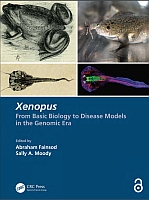Xenopus
Proposal review
From Basic Biology to Disease Models in the Genomic Era
| dc.contributor.editor | Fainsod, Abraham | |
| dc.contributor.editor | Moody, Sally A. | |
| dc.date.accessioned | 2022-03-21T14:33:06Z | |
| dc.date.available | 2022-03-21T14:33:06Z | |
| dc.date.issued | 2022 | |
| dc.identifier | ONIX_20220321_9781000529777_2 | |
| dc.identifier | ONIX_20220321_9781000529777_2 | |
| dc.identifier | OCN: 1264173677 | |
| dc.identifier.uri | https://library.oapen.org/handle/20.500.12657/53510 | |
| dc.description.abstract | This book focuses on the amphibian, Xenopus, one of the most commonly used model animals in the biological sciences. Over the past 50 years, the use of Xenopus has made possible many fundamental contributions to our knowledge in cell biology, developmental biology, molecular biology, and neurobiology. In recent years, with the completion of the genome sequence of the main two species and the application of genome editing techniques, Xenopus has emerged as a powerful system to study fundamental disease mechanisms and test treatment possibilities. Xenopus has proven an essential vertebrate model system for understanding fundamental cell and developmental biological mechanisms, for applying fundamental knowledge to pathological processes, for deciphering the function of human disease genes, and for understanding genome evolution. Key Features Provides historical context of the contributions of the model system Includes contributions from an international team of leading scholars Presents topics spanning cell biology, developmental biology, genomics, and disease model Describes recent experimental advances Incorporates richly illustrated diagrams and color images Related Titles Green, S. L. The Laboratory Xenopus sp. (ISBN 978-1-4200-9109-0) Faber, J. & P. D. Nieuwkoop. Normal Table of Xenopus laevis (Daudin): A Systematical & Chronological Survey of the Development from the Fertilized Egg till the End of Metamorphosis (ISBN 978-0-8153-1896-5) Jarret, R. L. & K. McCluskey. The Biological Resources of Model Organisms (ISBN 978-1-0320-9095-5) | |
| dc.language | English | |
| dc.subject.classification | thema EDItEUR::P Mathematics and Science::PS Biology, life sciences::PSC Developmental biology | en_US |
| dc.subject.classification | thema EDItEUR::P Mathematics and Science::PS Biology, life sciences::PSA Life sciences: general issues::PSAK Genetics (non-medical) | en_US |
| dc.subject.classification | thema EDItEUR::P Mathematics and Science::PS Biology, life sciences::PSA Life sciences: general issues::PSAJ Evolution | en_US |
| dc.subject.classification | thema EDItEUR::P Mathematics and Science::PS Biology, life sciences::PSA Life sciences: general issues::PSAF Ecological science, the Biosphere | en_US |
| dc.subject.other | Developmental biology | |
| dc.subject.other | Genetics (non-medical) | |
| dc.subject.other | Evolution | |
| dc.subject.other | Ecological science, the Biosphere | |
| dc.title | Xenopus | |
| dc.title.alternative | From Basic Biology to Disease Models in the Genomic Era | |
| dc.type | book | |
| oapen.identifier.doi | 10.1201/9781003050230 | |
| oapen.relation.isPublishedBy | 7b3c7b10-5b1e-40b3-860e-c6dd5197f0bb | |
| oapen.relation.isFundedBy | George Washington University | |
| oapen.relation.isbn | 9781000529777 | |
| oapen.relation.isbn | 9781003050230 | |
| oapen.relation.isbn | 9780367505271 | |
| oapen.relation.isbn | 9780367505349 | |
| oapen.imprint | CRC Press | |
| oapen.pages | 360 | |
| oapen.remark.public | Funder name: Deptartment of Anatomy and Cell Biology George Washington University | |
| peerreview.anonymity | Single-anonymised | |
| peerreview.id | bc80075c-96cc-4740-a9f3-a234bc2598f1 | |
| peerreview.open.review | No | |
| peerreview.publish.responsibility | Publisher | |
| peerreview.review.stage | Pre-publication | |
| peerreview.review.type | Proposal | |
| peerreview.reviewer.type | Internal editor | |
| peerreview.reviewer.type | External peer reviewer | |
| peerreview.title | Proposal review | |
| oapen.review.comments | Taylor & Francis open access titles are reviewed as a minimum at proposal stage by at least two external peer reviewers and an internal editor (additional reviews may be sought and additional content reviewed as required). |

